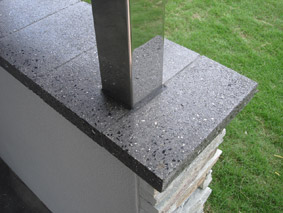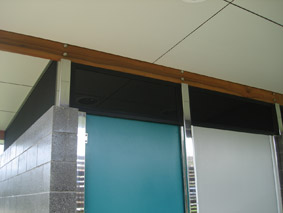
19 years plus points to stainless
A fresh focus on whole-of-life costing at Gold Coast City Council has led to the specification of stainless steel for long-term structures in the foreshore zone.
The philosophy, which was adopted following the publication of a study by Griffith University and GCCC, is likely to have flow on effects to other councils and government bodies.
GCCC’s co-ordinator of technical governance Paul Conolly said the seed was planted in 1998 when Council’s Technical Services Branch specified stainless steel for a modular toilet structure in a foreshore zone park. The material was deemed at the time to be cost prohibitive on a capital expenditure basis but the process sparked an interest in lifecycle costing.
Mr Conolly said Council’s growing interest in lifecycle costing, combined with an expectation among locals and tourists that public facilities showcase a ‘resort style’ finish, had brought the focus back to stainless steel in recent years. “There has been a clear trend towards lighter, more open structures for public facilities and these lend themselves to steel work,” he said. “A lot of our public facilities are in the foreshore zone and some materials weren’t performing as well as we wanted, so we started to look at corrosion issues and how to best manage this. We started using stainless steel for critical elements, such as joint interfaces for concrete works; bolts, brackets and cleats for boardwalks; and for high use facilities such as rubbish bins.
“Our observations led us to believe that stainless was the way to go in the foreshore zone, but we had no tangible justification which the designers could use to validate the decision for our asset custodians. We needed clear evidence to prove the initial cost of stainless steel was justified over the life of the structures.”
Griffith University scholarship student Jordan Cocks was called on to research the topic in conjunction with industry affiliate GCCC as partial fulfilment of his Bachelor of Civil Engineering.
Mr Cocks investigated multiple structural scenarios from the perspective of what would represent the most cost-effective solution: hot dipped galvanized (HDG) steel, paint systems, duplex systems using both HDG and paint, or stainless steel.
The result was a report containing a design guide, a life cycle cost analysis and a life cycle costing spreadsheet for structures in the foreshore zone. The report indicates stainless steel is a viable option based on cost alone for structures with a design life greater than 19 years. Conversely, the study indicates a HDG coating would theoretically have a life span of 14 years, leaving the exposed steel subject to rapid corrosion unless protected by an increasingly costly maintenance regime.
Mr Conolly said the report had delivered a workable tool enabling designers to input various parameters, such as current prices and design life, producing a guide for selection of the appropriate material or finishes based around optimising whole-of-life costs.
Similar principles were used to shift the specification of a park arbour in Broadbeach towards stainless steel. The material was essential due to the warm, humid environment of the foreshore, regular spraying with water and fertiliser, and the fact that the arbour would have plants growing over it that would take many years to fully establish. The report has now been used to guide material selection for a number of projects, including toilet blocks in Jacobs Well, Miami (pictured) and Burleigh Heads.
“With these projects, we have gone to the asset custodians and our first question was – what is the design life?” Mr Conolly said. “The report has helped reinforce the need for a ‘cradle to grave’ approach to responsible and sustainable asset management encompassing all stakeholders. This includes not just the designer and asset custodian but all the operational and maintenance personnel involved with a structure.
“For stainless steel structures, the asset custodians now recognise that to retain an asset over the long-term and to satisfy the whole of life cost advantage there must be regular wash downs as part of the maintenance program. The higher initial construction costs are offset by the lower cost regular wash downs which form the major component in the new maintenance regimes. The buildings are also being designed to be hosed from ceiling to floor. The overall process has really helped improve the relationship between the asset custodians, designers and maintenance staff.”
Mr Conolly said the report had also been used to promote the use of stainless steel in playground equipment and shade sail structures. “It is just a matter of making that little leap towards recognising the whole-of-life cost and ensuring delivery of a durable product – it’s not rocket science, just common sense when you think about it.”
GCCC is also now favouring ASSDA Accredited Fabricators and looking to ASSDA to provide third party technical expertise or adjudication should conflicts arise relating to material performance. The ASSDA Accreditation Scheme requires fabricators to conform to stringent standards of competence, training and education and encourages a consistently high standard through industry self-regulation.
ASSDA Executive Director Richard Matheson said GCCC’s decision to favour ASSDA Accredited Fabricators and specify stainless steel in the foreshore zone was a welcome one. “I believe we will see this initiative mirrored by other councils and government bodies in the near future,” Mr Matheson said.
“There is no doubt that informed specification and quality fabrication by people who know and understand the material will offer long-term cost savings and extend the life of the product. This is why ASSDA places so much emphasis on education and technical expertise – Councils and other government bodies need to get it right the first time and ensure value for money for their constituents.”
Mr Conolly said for long term structures, stainless steel was becoming the default specification in the foreshore zone and the trend was even moving inland.
“We’re asking the question: what will look and perform best from cradle to grave? It’s making people think differently,” he said.
Download the the final report here (4.6MB) - Whole of Life Cost Comparison and Cost Benefit Analysis for Steel Structures Constructed in the Foreshore Zone.


This article featured in Australian Stainless magazine - Issue 48, Autumn 2011.